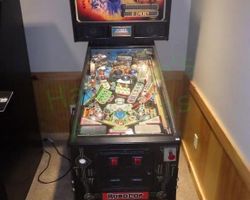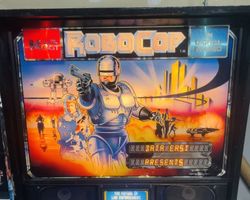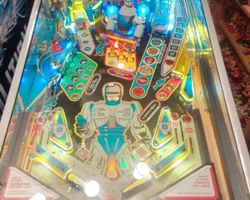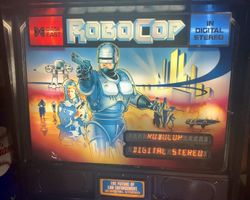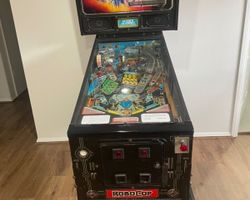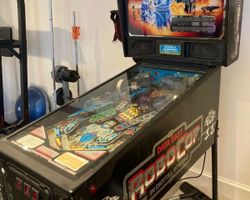Robocop
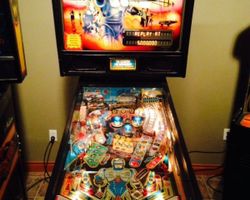
Average Prices: USD $400 to $1,600
Produced: November, 1989
Production Run: 1,500 units
Machine Type: Solid State Electronic
MPU: DataEast/Sega Version 2
Players: 4
Design by: Ed Cebula, Joe Kaminkow
Art by: Kevin OConnor, Kevin O'Connor
Dots/Animation by: Hudson Graphics
Music by: Scott Stevenson, Mark Cross
Sound by: Scott Stevenson, Mark Cross
Software by: Rob Quinn
Data East entered the late 1980s pinball scene aiming to capture attention with licensed themes, translating popular culture into compelling silverball experiences. Released in November 1989, RoboCop brought the gritty, satirical world of Omni Consumer Products and Detroit's cyborg law enforcement officer to the arcade floor. Based directly on the successful 1987 film, the machine sought to immerse players in the action and dark humor of its source material.
The development involved key figures within Data East's pinball division. Ed Cebula and Joe Kaminkow handled the design aspects, while Kevin O'Connor provided the artwork. The critical task of software development fell to Rob Quinn, with Scott Stevenson and Mark Cross composing the music and sound effects, aiming to replicate the movie's distinct audio signature. Hudson Graphics contributed animations for the display. Data East produced approximately 1,500 units of RoboCop between November 1989 and January 1990. While not a massive production run compared to some contemporaries, it represented Data East's continued effort to leverage recognizable intellectual properties. An interesting technical footnote is that RoboCop marked the debut of Data East's solid-state flipper system. This design replaced the traditional mechanical end-of-stroke switch with solid-state circuitry, aiming for improved reliability and feel – a development direction other manufacturers would also pursue.
Signature Features and Design
The most defining physical characteristic of RoboCop is its unique "Jump Ramp." Located centrally on the playfield, this metal ramp features a deliberate gap. A well-aimed shot sends the ball speeding up the incline, launching it across the gap to continue down the return wireform. However, a weak shot results in the ball failing to clear the chasm, dropping instead into the pop bumper area below. This feature introduces a distinct risk-reward dynamic and a satisfying skill shot that demands precise flipper control. Successfully clearing the jump ramp is a core element of the gameplay experience.
Beyond the mechanical novelty, RoboCop heavily relies on its theme integration. The machine incorporates numerous sound effects and voice callouts directly sampled from the movie. Hearing RoboCop declare "Dead or alive, you're coming with me!" or the menacing countdown of ED-209 adds significantly to the player's immersion. The alphanumeric display supplements this with thematic messages and scoring information, attempting to tie the pinball action back to the narrative of fighting crime in Old Detroit. While physical toy integration is minimal compared to later machines – notably lacking a fully sculpted ED-209 – the audio-visual package works hard to deliver the RoboCop atmosphere.
Playfield and Mechanics
The RoboCop playfield presents a relatively open layout dominated by the central jump ramp. Flanked by two main flippers at the bottom, the design encourages fast ball movement and rewards accurate shooting. Key features include:
- The Jump Ramp: As mentioned, the central focus. Successful shots often feed the right flipper for potential combo opportunities or further ramp attempts. Failed shots divert the ball into the chaos of the pop bumpers.
- Left Orbit/Spinner: A shot up the left side travels behind the top lanes, potentially increasing the value of the lit spinner along the way before feeding the top rollover lanes.
- Target Banks: Various targets are strategically placed. Stand-up targets spelling R-O-B-O-C-O-P are situated on the left side, crucial for lighting features and scoring. Another bank exists on the upper right.
- Pop Bumpers: A standard triangle of three pop bumpers resides below the jump ramp's gap, adding unpredictability when the ball falls short or is fed from the upper lanes.
- Captive Balls: Three captive balls are located near the center-left of the playfield. Hitting these is often tied to specific objectives or building towards multiball.
- Right Ramp/Loop: A shot on the upper right feeds a habitrail that returns the ball to the left flipper, allowing for controlled setups.
- Kickback: A left outlane kickback, often themed as "OCP Crime Wave," offers a chance to save the ball from draining.
The design philosophy emphasizes speed and hitting specific major shots, particularly the jump ramp and the left orbit. While not overly complex, the layout provides clear objectives. The flow allows players to string together shots, looping the right ramp return to the left flipper to set up another attempt at the jump ramp or the R-O-B-O-C-O-P targets.
Aesthetically, Kevin O'Connor's artwork attempts to capture the movie's feel, though opinions on its success vary. The playfield art features depictions of RoboCop, villains like Clarence Boddicker, and scenes related to OCP. The color palette uses blues, reds, and blacks prominently. Lighting plays a role, with flashers accentuating key moments like successful ramp shots or mode starts. The backglass art generally receives positive remarks for its depiction of the main character. The overall look aligns with the typical Data East style of the era, utilizing bold lines and character illustrations.
Gameplay Dynamics
RoboCop's gameplay revolves around completing objectives tied to the movie's plot points and triggering high-scoring features like multiball. The core ruleset involves shooting specific targets and ramps to progress. Spelling R-O-B-O-C-O-P via the left target bank is often a primary goal, lighting inserts that enable other features or contribute towards starting multiball.
Key gameplay elements include:
- Multiball: A 3-ball multiball sequence provides a frantic scoring opportunity. Initiating multiball typically involves locking balls, often through shots to the captive balls or other designated areas after meeting certain prerequisites. Keeping all three balls in play while hitting jackpots (often the jump ramp) is the main challenge.
- ED-209 Hurry-Up: This mode simulates a confrontation with the malfunctioning enforcement droid. Triggered by specific shot combinations, it presents a timed challenge where players must hit designated shots (like the jump ramp) repeatedly before time expires for substantial point awards. The accompanying sound effects heighten the intensity.
- Jump Ramp Scoring: Beyond its mechanical function, the jump ramp is a crucial scoring shot, especially when lit for jackpots during multiball or specific modes. Repeated successful jumps are often key to achieving high scores.
- Spinner Value: The left orbit spinner can be advanced in value, making repeated shots through this lane lucrative, especially if the player can consistently hit it.
- Modes/Directives: The game presents various "directives" or mini-modes based on combating crime, requiring players to hit specific shots or targets within a time limit.
Gameplay strategy often involves mastering the jump ramp shot for consistency, learning the shots required to start multiball and the ED-209 mode, and capitalizing on these high-scoring opportunities. The kickback adds an element of ball preservation, crucial given the game's potential for quick drains down the outlanes. While not possessing the intricate, multi-layered rulesets of later machines, RoboCop offers direct, action-oriented objectives that align well with its theme.
Reception and Legacy
Within the pinball community, RoboCop often evokes positive sentiment, frequently described as fun, fast, and addictive. Its strongest praise centers on the successful theme integration; the use of authentic sounds and callouts from the movie is widely appreciated and considered highly effective in capturing the source material's essence. The jump ramp consistently stands out as a favorite feature, lauded for its unique mechanism and satisfying feel when executed correctly. The multiball sequence is generally regarded as challenging and rewarding, and the overall light show, incorporating flashers, adds visual excitement. Many find it approachable for newer players while still offering enjoyable gameplay for regulars.
However, the machine is not without criticism. The most common point of contention is the playfield artwork. Many players feel it appears dated, overly simplistic, or fails to capture the darker, grittier tone of the film, sometimes citing the color choices or illustrative style. Another frequent critique concerns the ruleset, which some experienced players find somewhat shallow or repetitive compared to deeper games, feeling the objectives lack long-term variation. Shot reliability can also be a factor, with certain shots occasionally prone to rejection. The absence of a more elaborate ED-209 toy, relying instead on a plastic cutout, is often noted as a missed opportunity. Some players also find the game prone to quick ball drains, labeling it potentially "brutal."
Despite these points, RoboCop maintains a reputation as a solid and often underrated Data East title from its era. Its influence can be seen directly in Data East's 1991 release, 'Checkpoint,' for which designer Joe Kaminkow reused and modified the core playfield layout, suggesting satisfaction with its fundamental flow. The introduction of Data East's solid-state flipper technology in this machine was also a notable, albeit internal, step forward. RoboCop stands as a good example of Data East's strategy in the late 1980s: leveraging popular licenses with engaging, accessible gameplay centered around a standout mechanical feature.
 Active Auctions
Active Auctions
 Auction Results
Auction Results
| Cost | Location | Date |
|---|---|---|
| USD $3,000 |  Kansas, United States Kansas, United States |
27 March, 2025 |
| USD $4,399 |  United States United States |
21 December, 2024 |
| AUD $6,500 |  New South Wales, Australia New South Wales, Australia |
02 July, 2024 |
| USD $2,999 |  Florida, United States Florida, United States |
02 August, 2023 |
| USD $2,650 |  United States United States |
09 January, 2023 |
| USD $2,000 |  Ohio, United States Ohio, United States |
25 August, 2022 |
| GBP £2,600 |  Reading, United Kingdom Reading, United Kingdom |
05 June, 2022 |
| GBP £1,245 |  United Kingdom United Kingdom |
29 April, 2021 |
| USD $1,750 |  Maryland, United States Maryland, United States |
21 April, 2021 |
| USD $2,100 |  Indiana, United States Indiana, United States |
09 September, 2020 |


Private Policy · Search Website · Contact Us
All trademarks and copyrighted materials remain property of their respective owners.
All other content copyright 2007 - 2025 Pinpedia.

